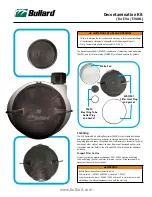
__________________________________________________________________________________
2
Content
:
1. Introduction
2. Preconditions for use
3. Unpacking / Assembly / Usage
4. Before use
5. Maintenance / Cleaning
6. Spare parts, replacing spare parts
7. Fault finding
8. Storage
9. Warranty
10. Technical data
11. List of parts
1. Introduction
CleanAIR is a respiratory protective system which
is based on the principle of circulated
overpressured air in the hood. The belt-mounted
blower unit delivers air through a filter and via an
air hose into a headpiece (a hood or mask). The
supply of filtrated air creates positive pressure
inside the headpiece, which prevents the external
contaminated air from entering the user’s breathing
zone.
The supply of air also ensures the user comfortable
breathing without him having to overcome the
resistance of the filters. For an adequate and
efficient protection it is necessary to choose the
correct combination of a respiratory unit, suitable
filters and a protective headpiece.
CleanAIR BASIC 2000 respiratory system meets
the European standard EN 12941.
It provides protection against non-toxic and toxic
particles, solid and liquid aerosols.
CleanAIR C
hemical
respiratory system meets
the European standards EN 12941 and EN 12942.
It provides protection against particles, solid
and liquid aerosols and harmful gases depending
on the type of filters used.
2. Preconditions for use
The user must read and understand all the
following “ Instructions for Use” well to be able to
use the respiratory protective system correctly.
•
Oxygen concentration in the surrounding area
must not drop under 17
%.
•
Type and concentration of the contaminants in
the working place must be known to the user.
•
The CleanAIR respiratory system must not be
used in unventilated areas such as tanks, pipes,
canals etc.
•
The CleanAIR respiratory system must not be
used in areas with danger of explosion.
•
Use the respiratory system only with the blower
unit switched on.
•
Check the air flow before use.
•
If the blower unit stops working due to any
reason, the user must leave the contaminated
area immediately.
•
If the blower unit is switched off, the respiratory
system gives little or no respiratory protection.
Also there is a risk of high concentration of
carbon dioxide (CO2) and of oxygen reduction
inside the headpiece.
•
Attention! During a load of really hard work
negative pressure may occur inside the hood if
the user’s breathing becomes too intensive and
thus the protective factor can decrease.
•
Make sure that the headpiece fits the user´s face
perfectly. Only then the efficiency of the system
is sufficient. The protective factor of the complete
system is reduced if the seal of the headpiece is
not fitted properly, for eg. due to beards or long
hair intervening into the seal line.
•
Make sure that the air hose doesn‘t make a loop
and doesn’t get caught on something in the
surrounding.
GB
3




























